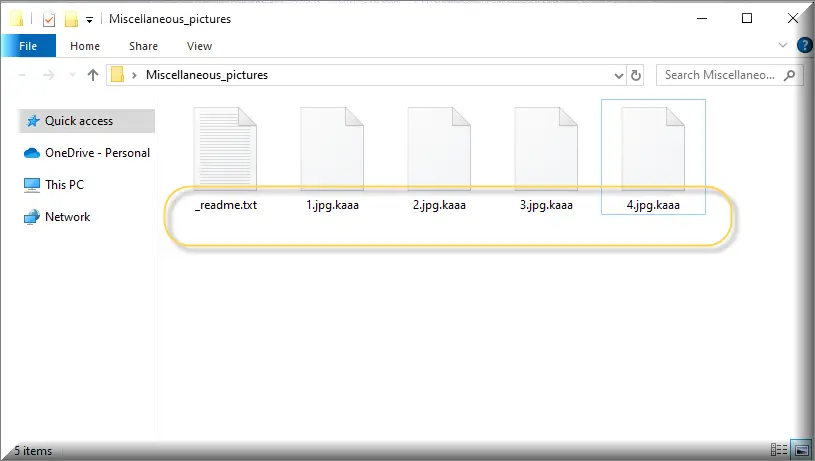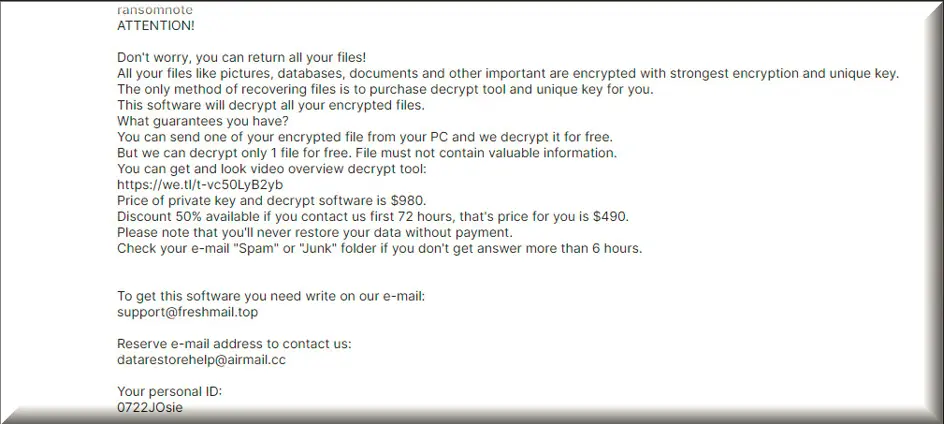
*Kaaa is a variant of Stop/DJVU. Source of claim SH can remove it.
The Kaaa File
The Kaaa file is a file format that is unreadable by conventional software. Attempting to open this file type with your current software will result in an error message, as it demands a unique decryption key to be accessed. The presence of an Kaaa file on your system generally implies that you’ve fallen prey to a ransomware attack. To your regret, ransomware is a malicious software category used by cyber criminals to deny you access to your own files. They encrypt your data, append an extension to it, and keep it locked until a specified ransom is paid. If the ransom is not paid within the deadline, your data could become irretrievably lost or deleted.

How to decrypt Kaaa ransomware files?
How to remove Kaaa ransomware virus and restore the files?
The Kaaa Virus
The Kaaa virus is an emergent ransomware threat that infiltrates your system via several channels, the most prevalent being attachments in spam emails. Upon download, the email attachment triggers the ransomware program, which initiates the encryption of your system files. Additional methods of distribution include tactics of social engineering, downloads of harmful web content, deceptive ads and chat messages. It’s not unusual for the Kaaa virus to enter your system via an executable file that’s tucked inside a zip folder, a macro in a Microsoft Office document, or disguised as a legitimate attachment. Therefore, you should always be careful what content you interact with and try to avoid any suspicious links, ads, attachments or files.

Kaaa
Keeping your system safe from a ransomware like Kaaa begins with educating yourself about the risks associated with clicking on dubious links or downloading suspicious attachments. Being careful while online and having reliable security software operational on your system can reduce the likelihood of successful malware attacks. It’s also vital to regularly update your software, as many ransomware threats exploit vulnerabilities that users don’t promptly address. However, the best strategy to minimize the impact of a potential Kaaa attack is to regularly backup your data, either on an external drive or in the cloud.
.Kaaa
.Kaaa is a process used by the Kaaa ransomware to encrypt your digital files, making them inaccessible. Detecting this process is difficult because it generally occurs invisibly. If you’ve been hit by .Kaaa, Uazq, Uajs, Vook, Looy or a similar threat, it’s crucial to resist the urge to pay the demanded ransom. This is because cybercriminals cannot be relied upon to provide a decryption key after payment, leaving your data recovery uncertain. Hence, we suggest trying our free file recovery tips and using the professional Kaaa removal tool that you will find below before even considering paying the ransom. Moreover, adhering to the guide’s instructions will aid in removing the infection from your computer.
Kaaa Extension
The Kaaa extension is an identifier that the Kaaa ransomware adds to all encrypted files on your system. This extension is typically appended to the original file extension, effectively distinguishing the encrypted file from its original format and preventing anyone from accessing it. Typically, the victims of Kaaa can differentiate between encrypted and unaffected files by searching for the Kaaa extension. For instance, a file named “file.doc” that has been encrypted by ransomware and assigned the extension “.Kaaa”, will be renamed to “file.doc.Kaaa” post-encryption. Of course, the extension that is added to the files encrypted by a ransomware threat may vary depending on the exact ransomware variant you’re infected with.
Kaaa Ransomware
Kaaa ransomware is a dangerous program designed by cybercriminals to encrypt your files and demand a ransom for their release. This threat can propagate through your network, applying encryption on your shared drives and other devices. It might remain inactive for a while, during which it can undermine your regular data backups, rendering them ineffective. To protect against Kaaa ransomware, we suggest regularly backing up your data on a storage medium like an external disk, or a cloud service provided by reliable vendors. Having secure offline backups can significantly improve your chances for file recovery in case you become a victim of a ransomware attack as you can easily copy your files once you remove the infection from the system.
What is Kaaa File?
An Kaaa file is a file that has been rendered inaccessible by the Kaaa ransomware encryption. Given that the ransomware threat can target and encrypt a variety of file types, such as documents, images, videos, databases, etc., an Kaaa file essentially refers to a regular file on your system (of any common file formats) that has been encrypted and has become unreadable by any software that you have. The encrypted file can usually be identified by its distinct file extension or altered file name, which helps both the attackers and the victims to identify which files have been compromised by the ransomware attack and which have not been affected.
SUMMARY:
*Kaaa is a variant of Stop/DJVU. Source of claim SH can remove it.
Kaaa Ransomware Removal

As a first step in this guide, we recommend that you bookmark this page in your browser’s Favorites. This will help you to quickly reload it after the system restart that follows.
The next step is to perform a Safe Mode Restart on the compromised machine (see this link for detailed instructions on this). When you start your computer in Safe Mode, only the most essential programs and processes are launched, allowing you to detect any Kaaa-related processes more easily.
Once in Safe Mode, type msconfig in the Windows search field and press Enter. After you’ve completed this, you’ll be able to see the System Configuration screen. Go to the Startup tab to check whether any of the items that start up when you start your computer are linked to the infection.

Do some online research if there are entries on your computer that have random names or Unknown Manufacturers, or anything else that cannot be related to any trusted programs you regularly use. Checking off the applicable checkbox box for them is the best way to disable them if you have enough solid information to do so.

WARNING! READ CAREFULLY BEFORE PROCEEDING!
*Kaaa is a variant of Stop/DJVU. Source of claim SH can remove it.
In the next step, look for suspicious processes that are running in the background of your system. This may be done by pressing CTRL + SHIFT + ESC to open the Task Manager window. The Processes Tab is where you’ll go to check if anything fishy is going on in the background. You can see how much memory and CPU are being used by each process and decide if this is a normal activity or not. Also, look at the names of the processes for something random or unusual. Right-click on any suspicious process and select Open File Location from the pop-up menu, just as shown below:

You can scan the files stored in the File Location folder for malicious code using the virus scanner provided below.

If the scan results indicate that the files are dangerous, go to the Processes tab, right-click on the process that is related to them and select End Process. After you have done that, delete the dangerous files from their location.

Open a Run command window by pressing the Windows key and R on the keyboard. Then, paste the following line in it:
notepad %windir%/system32/Drivers/etc/hosts
Click OK to run the command and open the Hosts file. You should be able to locate Localhost in the Hosts file that displays on your screen. A number of odd-looking IP addresses under Localhost at the bottom of your file may be an indication that your machine has been hacked. Look at the sample image below.

If you notice anything strange in your Host file, please leave a comment below this post, and we’ll tell you what to do and how to fix any problems we identify with the IPs.

*Kaaa is a variant of Stop/DJVU. Source of claim SH can remove it.
When a computer is hacked, malicious items can be introduced to the registry without the victim’s permission or knowledge. Ransomware threats like Kaaa are difficult to remove because of this – they tend to add helper entries that make it harder for the victim to get rid of the infection. In the following steps, however, you’ll learn how to look for files in your computer’s registry that need to be deleted.
Using the Windows search box, first type regedit and press Enter on the keyboard. The Registry Editor will be displayed on your screen. Next, CTRL and F can be used to look for entries relating to the infection. To do that, in the Find box that appears, type the ransomware’s name and click Find Next.
Registry file and directory deletions unrelated to Kaaa may damage your operating system and the software installed on it. To avoid causing any harm to your computer, it is best to use a professional removal tool, such as the one on this website. When it comes to identifying and eradicating malware from critical areas of your computer, such as the registry, this application excels.
Aside from cleaning the registry, it is also a good idea to enter each of the lines below in the Windows search field and check them for any Kaaa-related traces:
- %AppData%
- %LocalAppData%
- %ProgramData%
- %WinDir%
- %Temp%
In each place, look for files and folders with odd names or a date of creation near the date of the ransomware attack. If you can’t decide, use a powerful scanner and run a thorough check to help you decide whether or not something should be eliminated.
In the Temp folder, you can select and delete all the files that are stored there. This will remove any ransomware-created temporary files from your computer.

How to Decrypt Kaaa files
Ransomware is one of the most difficult types of malware to recover encrypted data from, therefore you may need to rely on different methods to decode parts of your data. In order to decide on the best method for recovering your files, you must first determine which variant of ransomware has infected your system. Checking on the encrypted files’ extensions can give you this information quickly and easily.
New Djvu ransomware
If you encounter files with the .Kaaa extension, it indicates that your system has been affected by the most recent variant of Djvu ransomware called STOP Djvu. However, there is some positive information available. Currently, there is a chance to decrypt files that have been encrypted by this variant, but this is only applicable if they were encoded using an offline key. To delve deeper into this topic and access a file-decryption program that can help you recover your files, kindly click on the provided link.
https://www.emsisoft.com/ransomware-decryption-tools/stop-djvu
To get the STOPDjvu.exe decryptor, just click on the “Download” button provided in the link. After the file is downloaded, right-click on it and choose the “Run as Administrator” option, then confirm by clicking “Yes”. Take a moment to review the license agreement and carefully follow the instructions provided on how to use the tool. Once you have completed these steps, you can start the decryption process for your data. Keep in mind that if your files were encrypted using unknown offline keys or online encryption methods, this tool may not be effective in decrypting them.
Before attempting any data recovery techniques, you must first remove the ransomware from the infected computer. Professional anti-virus software, such as the one on this site, can help get rid of Kaaa and other viruses. For additional assistance, you can make use of the free online virus scanner on this page. The comments section is also a good place to ask us questions and share your experience. We would be glad to know if we have helped you.

Leave a Reply